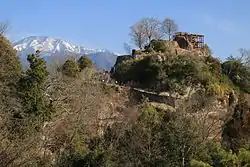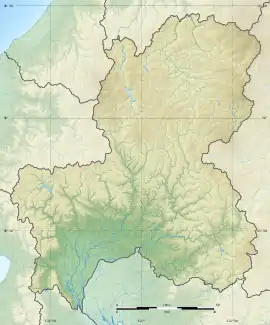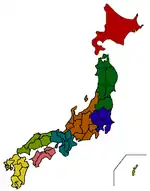Naegi Castle
Naegi Castle (苗木城, Naegi-jō) was a Japanese castle that formed the administrative center of Naegi Domain, a feudal domain of the Tōyama clan, located in what is now part of the city of Nakatsugawa in Gifu Prefecture, Japan. It also referred to as Misty Castle (霞ケ城, Kasumi-ga-jō), Naegi Castle was also known as "Akakabe Castle", as its walls were not white like many Japanese castles, but made with a reddish colored clay. The site has been protected as a National Historic Site since 1981.[1]
| Naegi Castle | |
|---|---|
苗木城 | |
| Nakatsugawa, Gifu Prefecture, Japan | |
 Naegi Castle and Mount Ena | |
 Naegi Castle  Naegi Castle | |
| Coordinates | 35°30′47.1″N 137°29′6.94″E |
| Type | Yamajiro-style Japanese castle |
| Site information | |
| Open to the public | yes |
| Condition | ruins |
| Site history | |
| Built | 1532-1555 |
| In use | Edo period |
| Demolished | 1871 |
History
The Tōyama clan were rulers of southeastern Mino Province since at least the Kamakura period. Naegi Castle was constructed in 1532 by Tōyama Naokado, the second son of Tōyama Kagetomo, the lord of Iwamura Castle and husband of Oda Nobunaga’s sister, Otsuya no Kata. His daughter was adopted by Nobunaga, and married to Takeda Katsuyori in an effort to stave off Takeda designs on Mino. After Iwamura Castle fell to the Takeda, Nobunaga considered Naegi Castle to be the most important defense against the Takeda clan.
However, following the assassination of Nobunaga in 1583 at the Honnō-ji Incident, the castle fell into the hands of Mori Nagayoshi. The Mori assigned Kawajiri Hidenaga as castellan and the Tōyama clan fled to Hamamatsu, where they went into the service of Tokugawa Ieyasu.
At the Battle of Sekigahara in 1600, Kawajiri sided with the pro-Toyotomi Eastern Army under Ishida Mitsunari, and was killed in battle. Ieyasu sent Tōyama Tomomasa, the son of its former castellan to take the castle. Afterwards, he was confirmed as a daimyō over his clan's ancestral holdings, which marked the start of Naegi Domain under the Tokugawa shogunate. The Tōyama clan remained at the castle through 12 generations until the Meiji Restoration.
Naegi Castle was abandoned and dismantled in 1871, with its furnishing and most of the buildings’ timbers being auctioned off to help pay off the domain's massive debt
Today, a restoration of the main keep strut-work now serves as a lookout over Nakatsugawa and the Kiso River. There is a museum below the castle site with a diorama showing what the castle looked like before its destruction.
Description
Naegi Castle occupies a very unusual layout on a bluff overlooking the Kiso River and the Nakasendo. This was a very strategic location, as it controlled both land and river routes between Owari Province and Mino Province.
The castle's layout utilizes the Kiso River as a natural moat to one side. The top of the hill was stripped of vegetation and soil; however the exposed massive boulders were left intact and were incorporated into the defensive walls. On top of the hill, an elaborate framework of timber formed a platform, on which the donjon was constructed. The donjon itself was 9 meters wide by 11 meters long, and stood three floors high.
The castle was listed as one of the Continued Top 100 Japanese Castles in 2017.[2]
Gallery
.jpg.webp) Naegi Castle Sannomaru
Naegi Castle Sannomaru Naegi Castle from Shiroyama Bridge
Naegi Castle from Shiroyama Bridge Toyama Historical Museum
Toyama Historical Museum Observation deck of Naegi Castle
Observation deck of Naegi Castle.jpg.webp) Umaarai Iwa
Umaarai Iwa
References
- "苗木城跡" (in Japanese). Agency for Cultural Affairs.
- "続日本100名城" (in Japanese). 日本城郭協会. Retrieved 25 July 2019.
Literature
- Schmorleitz, Morton S. (1974). Castles in Japan. Tokyo: Charles E. Tuttle Co. pp. 144–145. ISBN 0-8048-1102-4.
- Motoo, Hinago (1986). Japanese Castles. Tokyo: Kodansha. p. 200 pages. ISBN 0-87011-766-1.
- Mitchelhill, Jennifer (2004). Castles of the Samurai: Power and Beauty. Tokyo: Kodansha. p. 112 pages. ISBN 4-7700-2954-3.
- Turnbull, Stephen (2003). Japanese Castles 1540-1640. Osprey Publishing. p. 64 pages. ISBN 1-84176-429-9.
External links
![]() Media related to Naegi Castle at Wikimedia Commons
Media related to Naegi Castle at Wikimedia Commons
